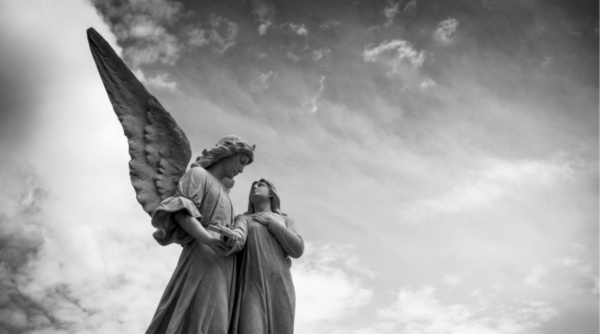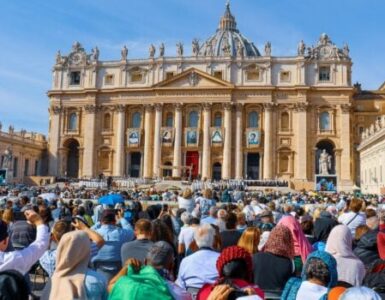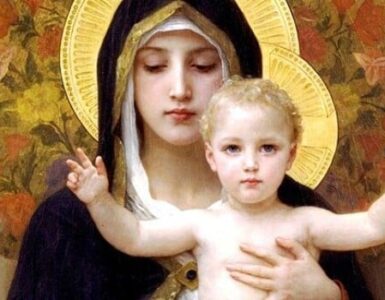The final part of This Present Paradise a series of Reflections on St. Elizabeth of the Trinity
(Start with part 1 here.)
“Mommy,” my eight-year-old daughter asked, “Guess which I am most excited for: First Confession, First Holy Communion, or Confirmation?” She waited expectantly for my answer. I looked at my little girl, who was about to receive all three sacraments that spring, with so much joy. “First Communion?” I had a hunch. “YES!” She danced around the room. “Because Jesus will be in me!”
Oh, my sweet, I wanted to say, Jesus will be in you in a new and profoundly beautiful way—to consummate your baptism in a mystery of union we can only begin to understand. But He is in you now, has always been in you with the Father and the Spirit, and delights in your innocent joy, the joy that spills out of your big brown eyes, windows into your interior heaven. But the moment slipped away just like the girl who went skipping out of the room to continue cutting out paper dolls.
This is the core of Elizabeth’s message. It certainly wasn’t original to her—it is solidly scriptural, straight from the mouth of Christ: “If a man loves me, he will keep my word, and my Father will love him, and we will come to make our home with him.” (Jn 14:23)
It is part of the cohesive continuum of Church teaching, as in the words of the great St. Teresa of Avila:
“If we consider the subject properly, sisters, we shall see that the soul of a just man is nothing else but a paradise, wherein the Lord takes His recreation. What a beautiful room then ought that to be, think you, in which a King so powerful, so wise, so pure, so full of every perfection, delights Himself? I know of nothing to which I can compare the great beauty of a soul, and its wonderful capacity.” (Interior Castle, I)
St. Elizabeth of the Trinity made this theology of the interior sanctuary where God dwells in the soul eloquently and transparently her own. She, true to her name and her mission, placed a particular emphasis on the Trinity: “At every moment of the day and night the three Divine Persons are living within you…You are never alone again!” (L 273)
She wanted us to understand that if union with God is our end, then heaven is not a destination but rather a completion, a perfection of a state of being. This blessed existence can and should begin in the here-and-now, anticipating, in her words, “the eternal present.” (Long Retreat, 44) “Time,” she would note, is simply “eternity begun and still in progress.” (HF 1) The soul which welcomes God, worships Him, and keeps company with Him in the interior temple knows in pale morning light what will be known later in full sun—the splendor of divine inheritance, the face of the Father. Thus we can live in an “anticipated heaven” (LR 21) which the Holy Spirit creates in us. We can live the life of heaven even now because “we possess our heaven within us.” (L 122)
This is nothing less than the Christian understanding of hope. Union with God isn’t something we hope ‘might’ happen in some distant future, but something we have been promised—should we keep God’s commands—and we look forward to in its fullness even while it begins in this very moment.
The purpose of our lives is not a remote future, but anticipated already now by faith. We begin to live our ultimate end—the union with the Trinity, even now in the secret center of our hearts where the Father, Son, and Holy Spirit begin to dwell at the moment of our baptism. (CCC 260)
In her short life, Elizabeth corresponded with six priests or seminarians, thirteen religious, and forty lay people. This means that it was her particular mission to reveal that our state in life is only the external framework for the fundamental call to the heights of holiness that was knit together in our center long ago. In other words, we can all have heaven in our soul and live in the spirit of the cloister in our homes, our high-rises, and highways. “Whatever may be our way of life or the clothing we wear, each of us must be the holy one of God.” (HF 24)
Not unaware of the constraints and struggles of lay life, she acknowledges a young mother’s tiredness and the distraction of her daily duties, but knows that what St. Catherine of Siena called the ‘inner cell’ of her interior life was accessible to the busiest, weariest, and most distracted of all of us. This she knew not only in theory; she knew from experience in the years before she had been allowed to enter the convent. Her concern was that all souls experience the interior Carmel she had discovered. This is remarkable because, in her time, there was less clarity around the call to sanctity: priests and nuns were thought to dwell in a higher plane of holiness; laity had a lesser vocation.
In this respect, St. Elizabeth anticipated the Second Vatican Council decades before its documents underscored and articulated the universal call to holiness. She is something of a prophet of this great swelling of our understanding of the sanctity of the laity which continues to shape the Church today. She was fully a daughter of the Church, gifted by the Spirit with a unique charism to help bring about within the family of God a renewal of the interior life and the sanctification of its members—all of them.
Elizabeth began her mission here on earth, but it continues even more fully from heaven.
The Carmelites in Dijon were among the first to have a devotion to St. Thérèse of Lisieux, so they were familiar with the Little Flower’s declaration that she would spend her heaven doing good on earth. As she neared her own death, Elizabeth was asked if she would do the same. Elizabeth said that she would, instead, shoot “like a rocket” deeper into the abyss of the Trinity! But still…she had a feeling that there was more for her to do. Maybe it would be more of a hidden mission, but she conceded to Mother Germaine that “I think in heaven my mission will be to draw souls by helping them go out of themselves to cling to God by a wholly simple and loving movement, and to keep them in this great silence within that will allow God to communicate Himself to them and transform them into Himself.”
So while St. Thérèse has a knack for making herself known (how many roses has she tossed at us?) Elizabeth would work wonders while hidden in the heart of God and in so doing, draw us deeper into the love of the Trinity. When a friend left the convent and asked Elizabeth to pray for an outward sign that she would return, Elizabeth hesitated. “That is not my grace,” she said. The sign that Elizabeth leaves to show that she with us is a completely interior one: that we find ourselves in a communion of love that we never thought we’d find.
I believe that God honored Elizabeth’s desire to be hidden for a long time as the cause for her canonization crept slowly forward. Finally, she was beatified by Pope John Paul II on November 25, 1984. The saint who preferred to be buried in the Trinity was brought out and presented to the Church as “a brilliant witness to the joy of being rooted and grounded in love,” reflected the Pope on that day. He said that her teaching on the mystical life of the soul was spreading “with a prophetic force.” Her feast day was declared to be on November 8 (the day of her death, November 9, was already celebrated as the feast of the dedication of St. John Lateran Basilica in Rome). It took three more decades for Elizabeth to officially be declared a saint, canonized by Pope Francis on October 16, 2016.
It was, at last, time to lift the bushel and let her particular light shine in our inner darknesses, to reveal the God who waits within our soul, and to usher in a new age of the Spirit—a hidden movement of souls plunging deep into their own interiority and transforming the Church and the world from the inside out. Of that, I am convinced, and I am convinced that you are reading this now because you are a part of that transformation. Let’s let her lead us back to the temple of our souls, dedicated at our baptism, and hold up a lamp in that consecrated place to show the off treasures within.
Show us, St. Elizabeth, that we do have everything.
We have our heaven within us, let’s live it.
(St. Elizabeth of the Trinity, Letter 120)
Editor’s note: this article originally appeared on SpiritualDirection.com and is reprinted here with kind permission.
Image courtesy of Pixabay.










